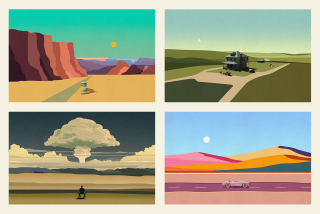Tiny Texas town in Oscar’s spotlight
- Share via
MARFA, Texas -- A thousand feet above a wind-swept, drought-browned valley, a man steps out of a late-’70s Ford Granada on a deserted two-lane road. He is confronted by a second man, who raises a pneumatic bolt gun to his forehead and deals a fatal blow.
Chip Love -- or “Man in Ford,” as the Oscar-nominated “No Country for Old Men” would come to credit him -- collapses to his knees on the blacktop, where Texas Ranch Road 2810 cuts through the crest of a hill covered in volcanic rock and tall, thick-trunked yuccas.
He gets up. He’s shot again. And again. And again. Eight times altogether he rises and falls.
Getting it right pretty much takes all day.
“It’s not as easy as it looks,” Love, 50, a local rancher and bank manager, laughs about his role as an early victim of psychopathic killer Anton Chigurh, played by Javier Bardem.
On another day, just a few miles to the west of Love’s “death,” a crew of oil field workers bounds down the stairs of a dusty depot, emptying a train pulled by an early 20th century steam locomotive. But this is a scene that will play out in “There Will Be Blood,” another film up for multiple Academy Awards.
This is no mere coincidence.
When Hollywood needs Western desolation, it comes to Marfa.
More than 50 years ago, famed filmmaker George Stevens also settled on this area for his epic Texas oil tale “Giant,” which starred Rock Hudson, Elizabeth Taylor and James Dean.
The stark, gorgeous landscape outside the town shows up in all three films.
“They wanted the openness, they wanted clear view for miles, they wanted nothing obstructing the view,” says rancher David Williams, describing his birthplace and where he’s raising his family. “And that’s what they found out here.”
Marfa, population 2,100, was founded as a railroad stop in 1883 and is believed to have been named by a rail executive’s wife after a character in Dostoyevsky’s “The Brothers Karamazov,” which she was reading at the time.
Now, the town with no movie theater is a big part of 16 nominations at this year’s Academy Awards on Sunday -- eight each for “No Country” and “There Will Be Blood,” including best picture, best director and, somewhat to Marfa’s credit, cinematography.
Its reputation as “the last frontier” is changing, however.
Marfa is becoming a micro version of the art mecca that Santa Fe, N.M., has become. Blocks of the tiny downtown, where a blinking stop light easily handles the sparse traffic, have been taken over by the foundations established by renowned artist Donald Judd, who moved to Marfa in 1972 and died 22 years later. Other artists set up galleries.
More to Read
Sign up for The Wild
We’ll help you find the best places to hike, bike and run, as well as the perfect silent spots for meditation and yoga.
You may occasionally receive promotional content from the Los Angeles Times.






